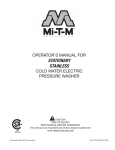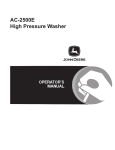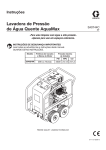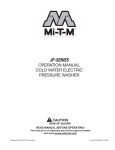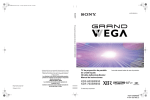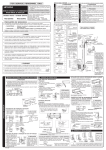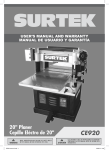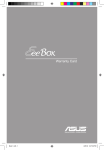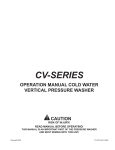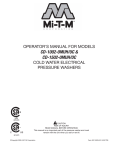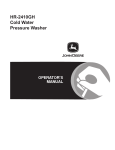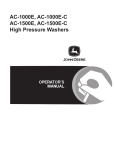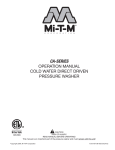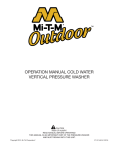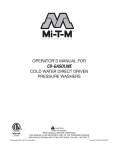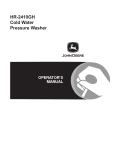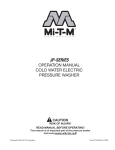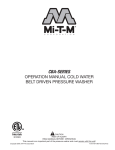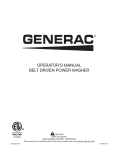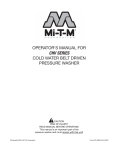Download PW-1500E
Transcript
OPERATOR'S MANUAL FOR MODEL PW-1500E COLD WATER ELECTRICAL PRESSURE WASHERS CAUTION RISK OF INJURY! READ MANUAL BEFORE OPERATING! This manual is an important part of the pressure washer and must remain with the unit when you sell or rent it! ©Copyright 2006, A & I Operator's Manual Form #37-0914-E/F/S-041906 table of contents introduction.................................................................................................................................... 3 important safety warningS................................................................................................... 4-7 ELECTRICAL PRECAUTIONS........................................................................................................ 4 SPRAY PRECAUTIONS.................................................................................................................. 5 DETERGENT CLEANING PRECAUTIONS..................................................................................... 6 MISCELLANEOUS SAFETY PRECAUTIONS................................................................................. 6 ADJUSTMENT PRECAUTIONS...................................................................................................... 7 FEATURES............................................................................................................................................ 8 safety decals.................................................................................................................................. 9 INSTALLATION & PREPARATION................................................................................................ 10-13 ATTIRE........................................................................................................................................... 10 SET-UP.......................................................................................................................................... 10 NOZZLE REVIEW.......................................................................................................................... 10 NOZZLE CONNECTION.................................................................................................................11 WATER SUPPLY.............................................................................................................................11 UNLOADER................................................................................................................................... 12 POWER CORD CONNECTION..................................................................................................... 12 THERMAL RELIEF VALVE............................................................................................................ 13 PRE-START INSPECTION PROCEDURES.................................................................................. 13 OPERATING INSTRUCTIONS....................................................................................................... 14-15 PRIMING THE PUMP.................................................................................................................... 14 START-UP...................................................................................................................................... 14 CLEANING WITH DETERGENTS................................................................................................. 15 SHUTDOWN.................................................................................................................................. 15 STORAGE & MAINTENANCE........................................................................................................ 16-17 SPECIFIC MAINTENANCE........................................................................................................... 16 WINTERIZING.......................................................................................................................... 16-17 START UP AFTER EXTENDED STORAGE.................................................................................. 17 TROUBLESHOOTING.................................................................................................................... 18-19 STATEMENT OF WARRANTY............................................................................................................ 20 NOTES................................................................................................................................................. 21 Operator's Manual INTRODUCTION Congratulations on the purchase of your new pressure washer! You can be assured your new pressure washer was constructed and designed with quality and performance in mind. Each component has been rigorously tested to ensure the highest level of acceptance. This operator's manual was compiled for your benefit. By reading and following the simple safety, installation, operation, maintenance and troubleshooting steps described in this manual, you will receive years of trouble free operation from your new pressure washer. The contents of this manual are based on the latest product information available at the time of publication. The manufacturer reserves the right to make changes in price, color, materials, equipment, specifications or models at any time without notice. ! important ! These paragraphs are surrounded by a "SAFETY ALERT BOX". This box is used to designate and emphasize Safety Warnings that must be followed when operating this pressure washer. Accompanying the Safety Warnings are "signal words" which designate the degree or level of hazard seriousness. The "signal words" used in this manual are as follows: DANGER: WARNING: CAUTION: Indicates an imminently hazardous situation which, if not avoided, WILL result in death or serious injury. Indicates a potentially hazardous situation which, if not avoided, COULD result in death or serious injury. Indicates a potentially hazardous situation which, if not avoided MAY result in minor or moderate injury. The symbols set to the left of this paragraph are "Safety Alert Symbols". These symbols are used to call attention to items or procedures that could be dangerous to you or other persons using this equipment. ALWAYS PROVIDE A COPY OF THIS MANUAL TO ANYONE USING THIS EQUIPMENT. READ ALL INSTRUCTIONS BEFORE OPERATING THIS PRESSURE WASHER AND ESPECIALLY POINT OUT THE "SAFETY WARNINGS" TO PREVENT THE POSSIBILITY OF PERSONAL INJURY TO THE OPERATOR. Once the unit has been removed from the box, immediately write in the serial number of your unit in the space provided below. SERIAL NUMBER_________________________________ Inspect for signs of obvious or concealed freight damage. If damage does exist, file a claim with the transportation company immediately. Be sure that all damaged parts are replaced and that the mechanical problems are corrected prior to operation of the unit. If you require service, contact your customer service at 888-835-1781. Please have the following information available for all service calls: 1. Model Number 2. Serial Number 3. Date and Place of Purchase Operator's Manual important safety instructions WARNING: When using this product, basic precautions should always be observed, including the following: READ ALL SAFETY INSTRUCTIONS BEFORE USING PRESSURE WASHER ELECTRICAL PRECAUTIONS: 1. GROUNDING INSTRUCTIONS: This product must be grounded. If it should malfunction or breakdown, grounding provides a path of least resistance for electric current to reduce the risk of electric shock. This product is equipped with a cord having an equipment-grounding conductor and a grounding plug. The plug must be plugged into an appropriate outlet that is properly installed and grounded in accordance with all local codes and ordinances. 2. DANGER: Improper connection of the equipment-grounding conductor can result in a risk of electrocution. Check with a qualified electrician or service personnel if you are in doubt as to whether the outlet is properly grounded. Do not modify the plug provided with the product - if it will not fit the outlet, have a proper outlet installed by a qualified electrician. Do not use any type of adaptor with this product. 3. GROUND FAULT INTERRUPTER PROTECTION: This pressure washer is provided with a Ground Fault Circuit Interrupter (GFCI) built into the plug or the power supply cord. This device provides additional protection from the risk of electric shock. Should replacement of the cord become necessary, use only identical replacement parts that include GFCI protection. 4. EXTENSION CORDS: WARNING THE MANUFACTURER DOES NOT RECOMMEND THE USE OF EXTENSION CORDS! If use of an extension cord is unavoidable, it must be plugged into a GFCI found in circuit boxes or protected receptacles. When using an extension cord, observe the following: Cable Length Wire Gauge Up to 50 feet 12 AWG 50 to 100 feet 10 AWG Use only 3-wire extension cords that have 3-prong grounding-type plugs and 3-pole cord connectors that accept the plug from the product. Use only extension cords that are intended for outdoor use. These extension cords are identified by a marking "Acceptable for use with outdoor appliances; store indoors while not in use." Use only extension cords having an electrical rating not less than the rating of the product. Do not use damaged extension cords. Examine extension cord before using and replace if damaged. Do not abuse extension cord and do not yank on any cord to disconnect. Keep cord away from heat and sharp edges. Always disconnect the extension cord from the receptacle before disconnecting the product from the extension cord. WARNING To reduce the risk of electrocution, keep all connections dry and off the ground. Do not allow electrical cords to lay in water or in such a position where water could come in contact with them. Do not touch plug with wet hands 5. DO NOT drop the GFCI as damage could result. If the GFCI is accidentally dropped, be certain to test the GFCI before using to ensure it is working properly. (Follow instructions on GFCI for test procedures.) 6. DO NOT pull on the electrical cord to disconnect from the outlet, OR carry the unit by the cord. 7. Check power cord for damage before using. There is a hazard of electrical shock from crushing, cutting or heat damage. 8. Always be certain the unit is receiving proper voltage. Before plugging the unit into a compatible power source, be certain the switch is in the "OFF" position. Disconnect when not in use. 9. DO NOT use the unit in an area where flammable gas vapors may be present. An electric spark could cause an explosion or fire. 10. DO NOT direct water spray on or into electrical installations of any kind. This includes electrical outlets, light bulbs, fuse boxes, transformers, the unit itself, etc. Severe electrical shock may occur. 11. The manufacturer does not recommend the owner attempt any electrical repairs to this unit. Operator's Manual important safety instructions READ ALL SAFETY INSTRUCTIONS BEFORE USING PRESSURE WASHER spray precautions: danger risk of injection or severe cutting injury keep clear of nozzle do not direct discharge stream at persons or pets when using this product, basic precautions should always be observed, including the following: 1. KEEP AWAY FROM THE SPRAY: a. Because of the high pressure and velocity of the spray, fluids can penetrate the skin, causing serious injury. b. Never point the gun at yourself or anyone else. Never put your hand, fingers or body directly over the spray nozzle. Always keep operating area clear of all persons. Use extreme caution when operating near children. c. If an accident does occur and the spray appears to have penetrated the skin, SEEK EMERGENCY MEDICAL CARE. DO NOT TREAT AS A SIMPLE CUT. If you are using cleaning agents, be prepared to tell a physician exactly what kind. 2. ALWAYS wear protective goggles when operating the unit to shield the eyes from flying debris and detergents. Other protective equipment such as rubber suits, gloves and respirators are advisable, especially when using cleaning detergents. Use extreme caution when operating near children. 3. Stay alert-watch what you are doing. Do not operate the unit when fatigued or under the influence of alcohol or drugs. 4. NEVER squeeze the trigger unless securely braced. The thrust from the water traveling through the nozzle may be powerful enough to cause the operator to lose balance if unprepared. DO NOT overreach or stand on unstable support. Wet surfaces can be slippery, wear protective foot gear and keep good footing and balance at all times. NEVER trigger the gun while on a ladder or roof. 5. Caution should be used when directing spray toward fragile materials such as glass. Shattering could result in serious injury. 6. ALWAYS hold on firmly to the gun/wand assembly when starting and operating the unit. Failure to do so can cause the wand to fall and whip dangerously. NEVER operate the gun with the trigger wired in the open position. To prevent accidental discharge, the trigger gun should be securely locked when not in use. 7. Even after you shut off the unit, there is high pressure water left in the pump, hose and gun until you release it by triggering the gun. Before removing the spray nozzle or servicing the unit, ALWAYS shut off the unit and trigger the gun to release trapped pressure. Operator's Manual important safety instructions READ ALL SAFETY INSTRUCTIONS BEFORE USING PRESSURE WASHER detergent cleaning precautions: 1. DO NOT use solvents or highly corrosive detergents or acid type cleaners with this pressure washer. Use only mild detergents. 2. KNOW YOUR DETERGENTS! Be prepared to tell a physician exactly what you are using in the event of an emergency. Read the Material Safety Data Sheet (MSDS) provided with your detergent and all detergent labels. Follow all appropriate instructions regarding preparation use, safety and transportation. Keep ALL detergents out of the reach of children. 3. DO NOT use this pressure washer to dispense hazardous detergents. 4. DO NOT alter the detergent injection feature in any manner not prescribed in this manual. Use only genuine manufacturer replacement parts for necessary repairs. miscellaneous safety precautions: 1. NEVER ALLOW CHILDREN OR ADOLESCENTS TO OPERATE THIS UNIT! 2. Read and follow all handling, operations, maintenance and safety instructions listed in this manual and provide such information to ANYONE who will be operating this unit. 3. This pressure washer is provided with a Ground Fault Circuit Interrupter (GFCI) built into the plug or the power supply cord, Should replacement of the cord or plug become necessary, use only identical replacement parts that include GFCI protection. 4. In freezing temperatures, the unit must always be warm enough to ensure there is no ice formation in the pump. DO NOT start this unit if it has been transported in an open or underheated vehicle without first allowing the pump to thaw. 5. When connecting the water inlet to the water supply mains, local regulations of your water company must be observed. In some areas the unit must not be connected directly to the public drinking water supply. This is to ensure that there is no feedback of the detergents into the water supply. (Direct connection is permitted if a back flow preventer is installed.) 6. High pressure hoses should be inspected daily for signs of wear. If evidence of failure exists, promptly replace all suspect hoses to prevent the possibility of injury from the high pressure spray. If a hose or fitting is leaking , NEVER place your hand directly on the leak. 7. DO NOT operate the unit if you see any pump oil or water leaks from the machine. DO NOT resume operation until the unit has been inspected and repaired by a qualified service person. 8. DO NOT operate the unit without all protective covers in place. 9. To reduce the risk of injury, maintain a safe distance from persons while operating this unit. Close supervision is necessary when operating the unit near children. 10. DO NOT leave pressurized unit unattended. Shut off the unit and release trapped pressure before leaving. 11. DO NOT move the unit by pulling on the hose. Operator's Manual important safety instructions READ ALL SAFETY INSTRUCTIONS BEFORE USING PRESSURE WASHER adjustment precautions: 1. NEVER alter or modify the equipment, be sure any accessory items and system components being used will withstand the pressure developed. Use ONLY genuine manufacturer parts for repair of your pressure washer. Failure to do so can cause hazardous operating conditions and will void warranty. 2. NEVER make adjustments to the machinery while it is connected to the power source. 3. Know how to stop the pressure washer and bleed pressures quickly. Be thoroughly familiar with controls. 4. Before servicing the unit; turn the unit off, disconnect from the power source, relieve the water pressure, and allow the unit to cool down. Service in a clean, dry, flat area. 5. Follow the maintenance instructions specified in this manual. ! save these instructions ! Operator's Manual JP SM-ELECTRIC FEATURES-041906-JJT features FEATURES LISTING 1. 2. 3. 4. 5. 6. 7. 8. 9. Variable Nozzle Assembly Gun Assembly GFCI - Ground Fault Circuit Interrupter Decal- Caution: Risk of Injury High Pressure Discharge Hose Thermal Relief Valve Water Outlet Water Inlet Strainer Water Inlet 10. Detergent Strainer 11. Detergent Hose 12. Oil Sight Glass 13. Pump 14. Adjustable Unloader Knob 15. Decal- Warning: Risk of Electrocution 16. Decal- Warning: Risk of Injection/Explosion 17. On/Off Switch Operator's Manual SAFETY DECALS & PLACEMENT DO not remove safety decals from unit unless replacing with most current safety decal!! Decal: Warning-Risk of Electrocution (Part #34-1013) WARNING Tag: Risk of Electrocution (Part #34-1035) ADVERTENCIA WARNING RISK OF ELECTROCUTION. DO NOT REMOVE THIS TAG. 1. Connect only to a properly grounded outlet. Do not remove ground pin. 2. Inspect cord before using. Do not use if cord is damaged. 3. Keep all connections dry and off the ground. 4. Do not touch plug with wet hands. 5. This product is provided with a Ground Fault Circuit Interrupter (GFCI) built into the power cord plug. If replacement of plug or cord is needed, use only identical replacement parts. 6. Do not use an extension cord with this machine. 7. Read the operator's manual before using. FAILURE TO FOLLOW THE ABOVE INSTRUCTIONS COULD RESULT IN A SEVERE ELECTRICAL SHOCK. RIESGO DE ELECTROCUCION. NO RETIRE ESTA CALCOMANIA. 1. Conecte solamente a un tomacorriente apropiadamente conectado a tierra. No retire la clavija de conexion a tierra. 2. Antes de usar inspeccione el cordon. si el cordon esta dañado no la use. 3. Mantenga todas las conexiones secas y alejadas del suelo. 4. No toque el enchufe con las manos mojadas. 5. Este producto viene con un interruptor de circuito de falla de conexion a tierra (GFCI) incorporado al enchufe del cordon electirco. Use solo piezas identicas de repuesto si se necesita un reemplazo del enchufe o del cordon. 6. No use un cordon de extension con esta maquina. 7. Antes de usar lea el manual del operador. EL NO SEGUIR LAS INSTRUCCIONES DE ARRIBA PUEDE RESULTAR EN UN CHOQUE ELECTRICO GRAVE. RISK OF ELECTROCUTION. DO NOT REMOVE THIS TAG. 34-1013-E/S-080699-ENG. Decal: Caution Statements (Part #34-1015) CAUTION 1. Connect only to a properly grounded outlet. Do not remove ground pin. 2. Inspect cord before using. Do not use if cord is damaged. 3. Keep all connections dry and off the ground. 4. Do not touch plug with wet hands. 5. This unit may be provided with a Ground Fault Circuit Interrupter (GFCI) built into the power cord plug. If replacement of the plug or cord is needed, use only identical replacement parts. If this unit is not provided with a GFCI, this unit should only be connected to a power supply receptacle protected by a ground fault circuit interrupter. 6. Do not use an extension cord with this machine. 7. Read the operator's manual before using. PRECAUCION RIESGO DE LESIONES RISK OF INJURY 1. Read operator's manual 1. Lea cuidadosamente el manual del operador antes carefully before using. de usar. 2. Spray gun can kick back. 2. El revolver rociadora Hold with both hands. puede retroceder 3. Risk of eye injury. Always violentemente. Sujétela wear eye protection. con ambas manos. 4. See the operator's manual 3. Riesgo de lesiones a los for proper chemical ojos. Use siempre protección para los ojos. usage. 4. Para un uso químico apropiado consulte el Manual del Operador. IMPORTANT IMPORTANTE • For indoor and outdoor use. • Store indoors. • Avoid pump damage. Protect from freezing. Do not run for more than 3 minutes with spray gun not triggered. • If connected to a circuit protected by fuses, use time-delay fuses only. CONNECT TO AN INDIVIDUAL BRANCH CIRCUIT ONLY. 34-1015-081099-E/S-ENG. • Para uso interior y exterior. • Almacene bajo techo. • Evite daños a la bomba. Protéjala contra la congelación. No haga funcionar por más de 3 minutos sin accionar el gatillo de la pistola. • Si se conecta a un circuito protegido por fusibles, use fusibles con retardo solamente. CONECTAR SOLAMENTE A UN CIRCUITO DERIVADO INDIVIDUAL. FAILURE TO FOLLOW THE ABOVE INSTRUCTIONS COULD RESULT IN A SEVERE ELECTRICAL SHOCK. 34-1035-E/F/S-111899-ENG Decal: Warning-Risk of Injection/Explosion (Part #34-1017) Decal: Important Pump Instructions (Part #34-1068) Operator's Manual INSTALLATION & PREPARATION attire: Proper attire is essential to your safety. It is advised to utilize whatever means necessary to protect eyes, ears, and skin. Additional safety attire (such as respiratory mask) may be required when using detergent cleaning agents with this washer. warning risk of explosion! do not operate unit in an area where flammable gas vapors may be present. An electric spark may cause an explosion. risk of bursting! do not store / operate unit in a freezing environment. warning SET-UP: 1. This unit should only be placed on a level surface to ensure proper lubrication for the water pump while operating. NEVER spray water directly on the unit! 2. Do not place unit in an area: a. where there is evidence of oil or gas leaks. b. where flammable gas vapors may be present. 3. Do not allow the unit to be exposed to rain, snow or freezing temperatures. If any part of the unit becomes frozen; excessive pressure may build up in the unit which could cause it to burst, resulting in possible serious injury to the operator or bystanders. 4. Before initial use, replace the oil travel plug with the dipstick provided with the unit. Be certain the oil level is in the center of the sight glass before each use. If low, fill with SAE20 or 30 non-detergent pump oil. DO NOT OVERFILL! NOZZLE review: The Adjustable Spray Pattern Nozzle (with lance) has two functions: risk of injection causing severe injury! NOTE: Nozzle assembly should NOT be connected to the gun assembly at this time. never look directly at the nozzle orifice unless it is disconnected from the gun/wand assembly! When using the adjustable nozzle, never adjust the spray pattern while the trigger gun is open! 1. Selections of high and low pressure can be achieved by pulling the nozzle cover at the end of the wand "TOWARD" yourself for the High Pressure setting, and pushing the nozzle cover "AWAY" from yourself for Low Pressure and detergent application. ADJUSTABLE NOZZLE 2. The spray pattern can be adjusted from 0° to 65° by rotating the nozzle cover at the end of the wand in a clockwise and counter-clockwise direction. Be cautious when using the straight narrow stream. It is not recommended for use on painted or wood surfaces OR items attached with adhesive backings. LOW PRESSURE / DETERGENT NOZZLE COVER HIGH PRESSURE NOZZLE COVER 10 Operator's Manual INSTALLATION & PREPARATION warning nozzle connection: 1. Be certain the trigger gun is locked in the "OFF" position. See WARNING, right. 2. The nozzle assembly should be disconnected from the gun assembly at this time by unscrewing the nozzle/lance assembly from the gun/lance assembly. risk of severe injury! the trigger gun should always be locked in the off position when not in use! DISCONNECT CONNECT water supply: 1. Select a water supply hose which is a quality grade of garden hose measuring at least 3/4" ID and no longer than 50 feet. CHECK wATER INLET STRAINER 2 Check the water inlet strainer to ensure it is clean and free of any obstructions. Periodic cleaning of the water strainer will help prevent pump problems. As a strainer becomes obstructed, it restricts proper flow of water to the pump. This can result in cavitations which will cause premature failure of pump packings and valves. Using a screw driver, remove the screen; clean or replace if necessary. 3. Connect the hoses. a. Connect one end of the water supply hose to the water inlet of the unit. b. Connect the other end of the hose to your pressurized water supply. NOTE: Do not use a non-pressurized water supply (i.e. from a well or pond) with this unit. c. Connect the high pressure discharge hose to the water outlet of the unit. 4. Follow the incoming water requirements listed below: a. Water pressure must be a minimum of 25 pounds per square inch (PSI) and a maximum of 125 PSI. (A typical outdoor faucet will generally supply this PSI if turned completely "ON".) b. Incoming GPM must be approximately one gallon more than the outgoing GPM stated on the pressure washer nameplate. (You can check GPM by timing how long it takes to fill a 5 gallon container. c. Incoming water temperature must not exceed 125°F (52°C). Excessive pump damage may result if the water temperature exceeds this acceptable level. 5. Never allow the unit to operate without the incoming water line attached and the water supply turned all the way on. Operator's Manual 11 INSTALLATION & PREPARATION caution risk of unit damage! do not overtighten the unLoader. breakage will result in immediate loss of water pressure and costly repairs. warning risk of electrocution! This unit must be connected to a properly grounded outlet. DO NOT use an adapter OR remove the third grounding prong. warning risk of electrocution! TO REDUCE THE RISK OF ELECTROCUTION, KEEP ALL CONNECTIONS DRY AND OFF THE GROUND. DO NOT TOUCH PLUG WITH WET HANDS. UNLOADER: The unloader valve on your machine is equipped with an adjustment knob to adjust the pressure. Should less pressure be required, simply turn the adjustment knob counterclockwise. To set back to maximum, turn adjustment knob completely clockwise. DO NOT OVERTIGHTEN! power cord connection: 1. Make certain the motor switch is in the "OFF" position. 2. Ensure electrical supply is identical to the specifications listed on the pressure washer data plate. 3. GROUNDING INSTRUCTIONS: This product must be grounded. If it should malfunction or breakdown, grounding provides a path of least resistance for electric current to reduce the risk of electric shock. This product is equipped with a cord having an equipment-grounding conductor. The plug must be plugged into an appropriate outlet that is properly installed and grounded in accordance with all local codes and ordinances. 4. DANGER: Improper connection of the equipment-grounding conductor can result in a risk of electrocution. Check with a qualified electrician or service personnel if you are in doubt as to whether the outlet is properly grounded. Do not modify the plug - if it will not fit the outlet, have a proper outlet installed by a qualified electrician. Do not use any type of adaptor with this product. 5. GROUND FAULT CIRCUIT INTERRUPTER PROTECTION: This pressure washer is provided with a Ground Fault Circuit Interrupter (GFCI) built into the plug or the power supply cord, test the GFCI each time it is plugged into an outlet according to instructions on the GFCI. DO NOT use the pressure washer if the test fails! The GFCI provides additional protection from the risk of electric shock. Should replacement of the plug or cord become necessary, use only identical replacement parts that include GFCI protection. 6. EXTENSION CORDS: THE MANUFACTURER DOES NOT RECOMMEND THE USE OF EXTENSION CORDS! If use of an extension cord is unavoidable, it must be plugged into a GFCI found in circuit boxes or protected receptacles. Use only 3-wire extension cords that have 3-prong grounding-type plugs and 3-pole cord connectors that accept the plug from the product. Use only extension cords that are intended for outdoor use. These extension cords are identified by a marking "Acceptable for use with outdoor appliances; store indoors while not in use." Use only extension cords having an electrical rating not less than the rating of the product. Do not use damaged extension cords. Examine extension cord before using and replace if damaged. Do not abuse extension cord and do not pull on any cord to disconnect. Keep cord away from heat and sharp edges. Always connect or disconnect the extension cord from the receptacle before connecting or disconnecting the product from the extension cord. 7. Ensure the area between the pressure washer cord and outlet is kept dry. 8. Insert the male plug into a grounded AC outlet. DO NOT use an adapter OR remove the grounding plug!! 12 Operator's Manual INSTALLATION & PREPARATION THERMAL RELIEF VALVE: To ensure the bypass water temperature does not exceed acceptable levels, never allow the pressure washer to operate in the bypass mode (with the unit running and the trigger closed) for more than three minutes. A thermal relief valve has been added to this unit to protect the pump. It may begin to open and release water if the water temperature in the pump has exceeded 140° F. This will allow fresh, cool water to enter the system, therefore preventing premature failure of pump packings. pre-start inspection procedures: Before starting the unit, perform the following procedures: 1. Check the oil level in the pump. 2. Inspect the inlet water strainer. Clean or replace if necessary. See "Water Supply", #2, pg. 11. 3. Check all hose connections to ensure they are securely tightened. See "Water Supply", #3, pg. 11. 4. Inspect for system water leaks and oil leaks. Be sure that all damaged parts are replaced and that the mechanical problems are corrected prior to operation of the unit. If service is needed, contact Customer Service. 5. Inspect high pressure hose for kinking, cuts or leaks. If a cut or leak is found, DO NOT USE HOSE! Replace hose before starting unit. See "Miscellaneous Safety Precautions" #6, pg. 6. Be sure that all damaged parts are replaced and that the mechanical problems are corrected prior to operation of the unit. If you need service, contact Customer Service. 6. Inspect electrical cord for cuts. If a cut is found, DO NOT TOUCH OR USE ELECTRICAL CORD! Replace cord before starting the unit. warning THE FOLLOWING PAGES CONTAIN OPERATING AND MAINTENANCE INSTRUCTIONS. do not attempt to operate this pressure washer until you have read and understood all safety precautions and instructions listed in this manual. incorrect operation of this unit can cause serious injury!! do not alter or modify this equipment in any manner! Operator's Manual 13 operating instructions priming the pump: 1. It is essential to prime the pump on initial start-up and each time the water supply is disconnected from the unit after initial use. 2. Lay the high pressure hose out to remove any loops. Water flow will constrict the hose, creating tight loops if the hose is not straight. 3. Securely connect the gun assembly to the high pressure hose. NOTE: The nozzle assembly should NOT be connected to the gun assembly at this time. See "Nozzle Connection" pg. 11. 4. With the trigger gun locked in the "OFF" position, turn the water supply completely on. Pointing the gun in a safe direction, unlock the trigger gun and squeeze the trigger. 5. Low pressure water will begin flowing from the hose/gun assembly. This allows the unit to prime and purge any air from the system. The unit is primed when water flow is uninterrupted by air. 6. Once the unit is primed, release the trigger and lock the gun in the "OFF" position. Securely connect the nozzle assy. (See "Nozzle Connection" pg. 11) WARNING RISK OF INJECTION CAUSING SEVERE INJURY! KEEP CLEAR OF NOZZLE! NEVER PLACE HAND OR FINGERS IN FRONT OF NOZZLE! DO NOT DIRECT DISCHARGE STREAM AT PEOPLE OR PETS! BE CERTAIN THE Adjustable NOZZLE assy. IS SECURELY CONNECTED TO THE WAND TO PREVENT an ACCIDENTAL DISCHARGE! START-UP: 1. Refer to the "Safety Precautions" pgs. 4-7 before starting the unit. 2. Locate the Safety Decals on your unit and heed their warnings. 3. With the gun locked in the "OFF" position, point the trigger gun away from yourself or anyone else. Ensure water supply is turned completely on. 4. Disengage the safety lock-off on the gun and squeeze the trigger. Low pressure water will begin flowing from the nozzle. 5. Before starting the unit, brace yourself as the gun will kick-back from the high pressure created by the pump once the unit has started. 6. Move the On/Off Switch to the "ON" position. This switch includes a circuit breaker for protection of the motor. In case of excess load, the circuit breaker will automatically move the switch to the "OFF" position. To restart, move the On/Off Switch to the "ON" position again. 7. Once the unit is turned on, perform the following procedures with the gun open: a. Inspect for system water leaks and oil leaks. If an oil leak is found, TURN UNIT OFF IMMEDIATELY! Be sure that all damaged parts are replaced and that the mechanical problems are corrected prior to operation of the unit. If you require service, contact your customer service. b. Inspect high pressure hose for kinking cuts and leaks. If a cut or leak is found, DO NOT TOUCH HOSE AT CUT OR LEAK!!! TURN UNIT OFF IMMEDIATELY! Replace hose before re-starting the unit. See "Miscellaneous Safety Precautions #6, pg. 6. Be sure that all damaged parts are replaced and that the mechanical problems are corrected prior to operation of the unit. If you require service, contact your customer service. c. Inspect electrical cord for cuts. If a cut is found, DO NOT TOUCH OR USE ELECTRICAL CORD! Replace cord before starting the unit. 8. Trigger the gun several times and try adjusting the spray pattern. Be certain to LOCK the trigger gun in the "OFF" position whenever moving the adjustable nozzle. NEVER look directly into the nozzle! High pressure water creates CAUTION a risk of severe injury! 9. Do not allow unit to operate in bypass mode (with trigger closed) for more RISK OF DAMAGE. than three minutes without triggering the gun. Failure to follow this simple do not allow spray pattern rule can cause premature failure of pump packing seals, resulting in costly to remain on a fixed area pump repair. for an extended period of 10. Because your pressure washer delivers a high pressure spray and a variety time. possible damage may of spray patterns, there are many cleaning jobs that can be done without occur to the area. the use of detergents. If a cleaning agent is required, see "Cleaning With Detergents" pg. 15 for the correct procedures. 14 Operator's Manual operating instructions CLEANING WITH DETERGENTS: 1. Refer to "Detergent Cleaning Precautions" pg. 6 before working with detergents. Be certain to wear protective safety attire as stated on pg. 10. 2. Prepare detergent solution according to label directions. Never pump acids, alkaline, abrasive fluids or solvents through the unit. 3. Connect the detergent hose to the unit as shown on page 8. The detergent ratio is preset and cannot be adjusted. 4. Immerse the strainer into the detergent solution to allow detergent to siphon. 5. With the trigger gun locked in the "OFF" position, push the nozzle cover at the end of the wand away from the trigger gun. ADJUSTABLE NOZZLE DETERGENT LOW PRESSURE DETERGENT NOTE: This injection system is designed to apply detergents under low pressure only. It will not allow detergent solutions to be introduced into the system unless the nozzle cover at the end of the wand is moved away from the trigger gun in the low pressure detergent mode. 6. To apply solution, unlock the trigger gun and squeeze the trigger. In a few moments a detergent/water mixture will exit the low pressure nozzle. Start spraying the lower portion of the surface being cleaned and move up, using long overlapping strokes. Applying from the bottom up helps avoid streaking. Allow to soak briefly. (Avoid working on hot surfaces or in direct sunlight to minimize the chances of the detergent drying, which may result in damaging surfaces.) Be certain to rinse a small section at a time. 7. To rinse; lock the trigger gun in the "OFF" position, pull the nozzle cover at the end of the wand toward the gun. Unlock the trigger gun and spray. It will take about 30 seconds to purge all detergent from the line. For best rinsing results, start at the top and work down. 8. Siphon a gallon of water through the low pressure detergent injection system after each use. This prevents the possibility of corrosion or detergent residue causing mechanical problems during the next use. Shut-down: 1. Move the On/Off switch to the "OFF" position to turn unit off. 2. Turn the water supply "OFF". 3. Pointing the gun in a safe direction, trigger gun momentarily to relieve any trapped pressure. 4. Once pressure is relieved, disconnect the nozzle assembly. 5. Disconnect the unit from the power source. 6. Disconnect and drain gun, wand and hoses. 7. Wipe unit clean and store with gun, wand and hoses in a safe area. Operator's Manual 15 storage & maintenance SPECIFIC MAINTENANCE: PUMP: warning The pump oil must be changed after the first 25 hours of operation. Once the initial oil change has been completed, it is recommended the oil be changed every 3 months or 250 hour intervals. If oil appears dirty or milky, changes may be required at a greater frequency. Use SAE20 or 30 non-detergent pump oil and fill only to the center of the oil sight glass. DO NOT OVERFILL! NOZZLES: Nozzle orifices should be kept clean and free from obstructions. To clean nozzle orifice: 1. Disconnect the wand from the gun. risk of severe injury! to prevent accidental discharge, the adjustable nozzle/wand assembly must be disconnected from the gun assembly when using the nozzle cleaner. 2. Insert the nozzle cleaner into the nozzle and rotate. (See drawing, left.) 3. Flush the nozzle with water. 4. Reconnect the wand to the gun assembly. 5. Turn the unit "ON". Point the gun in a safe direction and trigger the gun to begin spraying. Adjust spray pattern to 0°. If spray pattern is still distorted, repeat steps 1-4. If you are unable to thoroughly clean the nozzle using this procedure, then the nozzle must be replaced. Water flow through the spray nozzle will erode the orifice, making it larger, resulting in a pressure loss. Nozzles should be replaced whenever pressure is less than 85% of the maximum. The frequency of replacement will depend upon such variables as mineral content in the water and number of hours the nozzle is used. To remove or replace adjustable nozzle: 1. Insert a 2.0 mm allen wrench into the nozzle. 2. Rotate the wrench counterclockwise to remove the nozzle. 3. Inspect the nozzle and clean or replace before reinserting. winterizing: warning risk of UNIT BURSTING! For storage and transportation purposes in subfreezing ambient temperatures, it will be necessary to winterize this unit. This unit must be protected to the lowest incurred temperature for the following reasons: do not store or operate unit in a freezing environment! 1. If any part of the pumping system becomes frozen; excessive pressure may build up in the unit which could cause the unit to burst resulting in possible serious injury to the operator or bystanders. 2. The pumping system in this unit may be permanently damaged if frozen. FREEZE DAMAGE IS NOT COVERED BY WARRANTY. 32˚F 0˚C If you must store your unit in an area where the temperature may fall below 32°F, you can protect your unit by following the procedure outlined below. 1. Gather the following items: a. Two 5 gallon containers. b. One gallon of antifreeze. (The manufacturer recommends an environmentally safe antifreeze.) c. Water supply. d. Three foot hose, 1/2-3/4 I.D. with a 3/4 inch male garden hose fitting. CONTINUED 16 Operator's Manual storage & maintenance winterizing, cONT'D: 2. Procedure: a. To start winterizing, unit must be run and primed according to the "Startup Procedures" listed on page 14. b. After running and priming, shut off the unit and water supply. c. Relieve system pressure by pointing the trigger gun in a safe direction and squeezing the trigger until water flow ceases to exit the nozzle. d. Lock the trigger gun in an OFF position and remove the nozzle. e. Remove the water supply hose from the unit and attach the 3 foot hose securely to the inlet connection. f. Shut off the detergent injector if applicable. g. Fill one 5 gallon bucket with water. h. Holding the 3 foot hose in an upright position, completely fill the hose with water. Then plug the hose outlet with your thumb or finger. Place the plugged end into the 5 gallon bucket of water. i. Turn the unit on. Trigger the gun several times until all the air is worked out of the system (unit is primed). NOTE: Proper winterizing is based on the recommended manufacturer's instructions listed on the "Protection Chart" shown on the back label of most antifreeze containers. j. With the trigger gun held open, siphon enough water out of the 5 gallon bucket until there is just enough water left to mix with the antifreeze. k. Point the wand into the empty container and start the unit. l. Trigger the gun until the antifreeze begins to exit the wand. Release the trigger for 3 seconds, then trigger the gun for 3 seconds. Continue cycling the gun several times until all the antifreeze mixture is siphoned from the container. m. Detach the 3 foot hose from the unit and drain any excess antifreeze back into the 5 gallon container. n. Disconnect the hose/gun/wand assembly from the unit and drain any excess antifreeze back into the 5 gallon container. o. Store the hose, gun and wand with the unit in a safe area. p. Store antifreeze solution for next use or dispose of according to state EPA laws. 3. Optional Procedure: a. Shut the unit off. b. Relieve system pressure by pointing the trigger gun in a safe direction and squeezing the trigger until water flow ceases to exit the nozzle. c. Disconnect and drain the hose, gun and wand. d. Start the unit and allow it to run until all the water exits the unit. Once the water has stopped flowing from the unit, turn off. NOTE: When using this procedure, caution should be used as ice chips can form from drops of water which could cause the unit to burst if starting before completely thawed. STARTING UNIT AFTER EXTENDED STORAGE: 1. BE CERTAIN the unit is NOT plugged into the power source. 2. Prior to restarting the unit, thaw out any possible ice from the wand, gun, hose and unit. 3. After following all "PREPARATION" instructions, start the unit momentarily and immediately turn "OFF" to ensure all parts are lubricated before operation. Operator's Manual 17 TROUBLESHOOTING SYMPTOM PROBABLE CAUSE REMEDY Pump motor will not start, or stops GFCI tripped. while operating. Tripped circuit breaker or fuse blown in circuit fuse box. Disconnect all other plugs on the circuit being used and reset circuit breaker OR check and replace fuse. Loose or disconnected plug. Reconnect plug. Tripped circuit breaker in unit. Allow to cool and restart unit. Unit is frozen. Turn unit "OFF". Test GFCI by pressing reset button. Allow to thaw. If any part of the unit becomes frozen; excessive pressure may build up in the unit which could cause the unit to burst resulting in possible serious injury to the operator or bystanders. Circuit breaker trips or fuse blows in the Circuit overload. Check that the circuit is rated fuse box. correctly. 120 V/15 A/60 Hz for 1000 PSI 120 V/20 A/60 Hz for 1500 PSI 230 V/20 A/60 Hz for 2000 PSI Disconnect all plugs on the circuit. When connecting to a circuit protected by fuses, use time delay fuses only. Extension cord is too long or wire is too small. Too much pressure. Use correct electrical requirements as listed on pg. 4. Use Adjusting Knob on Unloader to reduce pressure. GFCI trips. Incorrect voltage. Ensure electrical supply is 120 V/15 A/60 Hz for 1000 PSI 120 V/20 A/60 Hz for 1500 PSI 230 V/20 A/60 Hz for 2000 PSI Electrical short to ground. Contact Customer Service. Water is leaking from Thermal Water inlet temperature is too high. Incoming water temperature must Relief Valve. be less than 140°F. Water temperature in unit is too high. Do not allow unit to operate in bypass mode (with the trigger gun closed) for more than three minutes. Defective valve. Replace. 18 Operator's Manual TROUBLESHOOTING SYMPTOM PROBABLE CAUSE REMEDY Motor runs but there is no discharge Inadequate water supply. at nozzle when trigger mechanism is squeezed. Kink in water inlet hose. Ensure hose is 3/4" diameter and incoming water supply is turned on. Replace hose. Kink in high pressure discharge hose. Low or fluctuating pressure. Water inlet screen obstructed. Pump sucking air. (Prime lost) Remove kink. Remove screen, clean or replace. Tighten all water intake connections. Eliminate leaks in intake line. Not in high pressure mode. Obstructed or worn orifice. Bypass valve not operating correctly. Pull the nozzle cover toward the gun to engage in high pressure mode. Oil appears milky or foamy. level. Water in oil. Change pump oil. Fill to proper Oil leaking from unit. DO NOT USE!!!!! Contact Customer Service. Detergent will not siphon into Low Pressure Detergent mode. Detergent strainer is not completely submerged in detergent solution Check; submerge if necessary. Detergent strainer is obstructed. Inspect, clean or replace. Detergent hose is obstructed, cut or kinked. Inspect, clean or replace. Not in Low Pressure mode. Nozzle assembly is plugged. Remove and clean, or replace. Repair or replace. Push nozzle cover away from the gun. Clean or replace. Too many high pressure hose Use one extension maximum. extensions attached to the water outlet. Ball & Spring in Venturi stuck. Remove, clean or replace. Water flows back into detergent container. Ball & Spring in Venturi reversed, missing or corroded. Remove, clean or replace. Water flows from the nozzle when the trigger gun is in the "OFF" position. Gun is malfunctioning. Repair or replace. Operator's Manual 19 STATEMENT OF WARRANTY The manufacturer warrants all parts, (except those referred to below), of your new pressure washer to be free from defects in materials and workmanship during the following periods: For Five (5) Years from the date of original purchase: High Pressure Pump For Two (2) Years from the date of original purchase: Cart Assembly Plumbing For One (1) Year from the date of original purchase: GFCI Selector Switch For Ninety (90) days from the date of original purchase: Trigger Gun/Wand High Pressure Hose Unloader Valve Strainer/Filter Defective parts not subject to normal wear and tear will be repaired or replaced at our option during the warranty period. In any event, reimbursement is limited to the purchase price paid. exclusions 1. The Motor is covered under separate warranty by its respective manufacturer and is subject to the terms set forth therein. 2. Normal wear parts: Pump Packings Spray Nozzles Pump Valves Detergent Valves Quick Couplings/Screw Connect O-rings 3. This warranty does not cover parts damaged due to normal wear, misapplication, misuse, operation at other than recommended speeds, pressures or temperature. Parts damaged or worn because of the use of caustic liquids or by operation in abrasive or corrosive environments or under conditions causing pump cavitation are not warranted. Failure to follow recommended operating and maintenance procedures also voids warranty. 4. The use of other than Genuine Manufacturer Repair Parts will void warranty. Parts returned, prepaid to our factory or to an Authorized Service Center will be inspected and replaced free of charge if found to be defective and subject to warranty. There are no warranties which extend beyond the description of the face hereof. Under no circumstances shall the manufacturer bear any responsibility for loss of use of the unit, loss of time or rental, inconvenience, commercial loss or consequential damages. 20 Operator's Manual NOTE Manual del Operador 21 TABLA DE MATERIAS INTRODUCCION.................................................................................................................................. 23 ADVERTENCIAS IMPORTANTES DE SEGURIDAD..................................................................... 24-27 PRECAUCIONES ELECTRICAS................................................................................................... 24 PRECAUCIONES PARA ROCIADO.............................................................................................. 25 PRECAUCIONES PARA LIMPIEZA CON DETERGENTES.......................................................... 26 PRECAUCIONES MISCELANEAS DE SEGURIDAD................................................................... 26 PRECAUCIONES DE AJUSTE...................................................................................................... 27 ELEMENTOS Y COMPONENTES.................................................................................................. 28-29 INSTALACION Y PREPARACION . ............................................................................................... 30-32 PROTECCIÓN PERSONAL........................................................................................................... 30 PREPARACION............................................................................................................................. 30 REPASO DE BOQUILLA................................................................................................................ 30 SUMINISTRO DE AGUA . ............................................................................................................. 31 DESCARGADOR........................................................................................................................... 32 CONEXIóN DE TOMA DE CORRIENTE PRINCIPAL................................................................... 32 VALVULA DE DESCARGA TERMICO........................................................................................... 32 PROCEDIMIENTOS DE INSPECCION ANTES DEL ARRANQUE............................................... 32 INSTRUCCIONES DE OPERACION.............................................................................................. 34-35 CEBADO DE LA BOMBA............................................................................................................... 34 ARRANQUE................................................................................................................................... 34 LIMPIEZA CON DETERGENTES.................................................................................................. 35 APAGADO...................................................................................................................................... 35 ALMACENAMIENTO Y MANTENIMIENTO................................................................................. 536-37 MANTENIMIENTO ESPECIFICO.................................................................................................. 36 PREPARACION PARA EL INVIERNO...................................................................................... 36-37 LOCALIZACION DE FALLAS........................................................................................................ 38-39 DECLARACION DE GARANTIA......................................................................................................... 40 22 Manual del Operador INTRODUCCION ¡Felicitaciones por la compra de su nueva lavadora a presión! Puede estar seguro que su lavadora a presión fue construida con el nivel más alto de precisión y exactitud. Cada componente ha sido probado rigurosamente por técnicos para asegurar la calidad, la resistencia y el rendimiento de esta unidad. Este manual del operador fue compilado para su beneficio. Leyendo y siguiendo los pasos simples de seguridad, instalación, operación, mantenimiento y localización de fallas descritos en este manual ayudará a prolongar aun más la operación libre de fallas que usted puede esperar de su nueva lavadora a presión. El contenido de este manual está basado en la información actualizada disponible al momento de la publicación. El fabricante se reserva el derecho de efectuar cambios en precio, color, materiales, equipo, especificaciones o modelos en cualquier momento sin previo aviso. ¡IMPORTANTE! Estos párrafos están rodeados por una “CASILLA DE ALERTA DE SEGURIDAD”. Esta casilla se usa par designar y enfatizar las Advertencias de Seguridad que deben seguirse al operar esta lavadora a presión. Acompañando a las Advertencias de Seguridad están las “palabras de alerta” que designan el grado o nivel de seriedad de riesgo. Las “palabras de alerta” usadas en este manual son las siguientes: PELIGRO: Indica una situación inminente riesgosa la cual, si no se evita, RESULTARA en la muerte o en lesiones graves. ADVERTENCIA: Indica una situación potencialmente riesgosa la cual, si no se evita, PODRIA resultar en la muerte o en lesiones graves. PRECAUCION: Indica una situación potencialmente riesgosa la cual, si no se evita PUEDE resultar en lesiones menores o moderadas. El símbolo indicado a la izquierda de este párrafo es el “Símbolo de Alerta de Seguridad”. Este símbolo se usa para alertarlo acerca de artículos o procedimientos que podrían ser peligrosos para usted u otras personas usando este equipo. PROVEA SIEMPRE UNA COPIA DE ESTE MANUAL A CUALQUIER PERSONA QUE USE ESTE EQUIPO. LEA TODAS LAS INSTRUCCIONES ANTES DE OPERAR ESTA LAVADORA A PRESION, OBSERVANDO EN PARTICULAR LAS “ADVERTENCIAS DE SEGURIDAD” PARA EVITAR LA POSIBILIDAD DE LESIONES PERSONALES AL OPERADOR. Escriba el número de serie de su unidad en el espacio provisto abajo, una vez que la unidad haya sido desempacada. NUMERO DE SERIE___________________________ Inspeccione por daño el contenido de la caja. Si algo parece dañado, NO LA DEVUELVA AL LUGAR DE COMPRA. Llame a su representante de servicio al cliente @ 888-835-1781. Por favor tenga disponible la información siguiente para todas las llamadas de servicio: 1. Número de modelo 2. Número de serie 3. Fecha y lugar de compra Manual del Operador 23 ADVERTENCIAS IMPORTANTES DE SEGURIDAD PRECAUCIONES ELECTRICAS: 1. INSTRUCCIONES DE CONEXION A TIERRA: Este equipo debe conectarse a tierra. La conexión a tierra provee un camino de resistencia reducida a la corriente eléctrica para reducir el riesgo de choque eléctrico, en caso de malfuncionamiento o falla. Este producto está equipado con un cordón que tiene un conductor de conexión a tierra del equipo y un enchufe de conexión a tierra. El enchufe debe enchufarse a un tomacorriente apropiado que esté correctamente instalado y conectado a tierra de acuerdo con todos los códigos y ordenanzas locales. 2. PELIGRO: La conexión incorrecta del conductor de conexión a tierra del equipo puede resultar en un riesgo de electrocución. Si usted tiene dudas acerca de si el tomacorriente está correctamente conectado a tierra, consulte con un electricista calificado o personal de servicio. No modifique el enchufe provisto con el producto. Haga instalar un tomacorriente apropiado por un electricista calificado, si el enchufe no entra. No use ningún tipo de adaptador con este equipo. 3. PROTECCION DEL INTERRUPTOR DE FALLA DE LA CONEXION A TIERRA: La lavadora a presión está provista de un Interruptor de Falla de la Conexión a Tierra (GFCI) incorporada al enchufe del cordón eléctrico. Este mecanismo provee una protección adicional contra el riesgo de choque eléctrico. Use sólo piezas de repuesto idénticas que incluyan protección GFCI, si fuera necesario reemplazar el cordón eléctrico. 4. CORDONES DE EXTENSION: ADVERTENCIA ¡EL FABRICANTE NO RECOMIENDA EL USO DE CORDONES DE EXTENSION! Si no puede evitarse el uso de un cordón de extensión, el mismo debe enchufarse a un GFCI ubicado en las cajas de circuitos o receptáculos protegidos. Observe lo sigu cable: Hasta 50 pies 12 AWG Entre 50 y 100 pies 10 AWG Use sólo cordones de extensión de 3 conductores que tengan enchufes de tipo de conexión a tierra de tres hojas y conectores de cordón de 3 polos que aceptan el enchufe del producto. Use sólo cordones de extensión que estén diseñados para uso al aire libre. Esos cordones de extensión están identificados por una marca que dice: “Aceptable para usar con artefactos al aire libre; almacene bajo techo mientras no se usa”. Use cordones de extensión que tengan una clasificación nominal que no sea menor que la clasificación nominal del producto. No use cordones de extensión dañados. Antes de usar examine el cordón de extensión y reemplácelo si está dañado. No maltrate el cordón de extensión y no tire del mismo para desconectarlo. Mantenga el cordón de extensión alejado del calor y de bordes aguzados. Antes de desconectar el equipo del cordón de extensión, desconecte siempre el cordón de extensión del receptáculo. ADVERTENCIA Mantenga todas las conexiones secas y alejadas de tierra, para reducir el riesgo de electrocución. NO permita que los cordones eléctricos y las conexiones permanezcan en agua o en una posición en la que el agua podría entrar en contacto con ellos. No toque el enchufe con las manos mojadas. 5. NO deje caer el GFCI ya que podría resultar en daños. 6. Para desconectar del tomacorriente, NO tire del cordón eléctrico, NI transporte la unidad por el cordón. 7. Antes de usar inspeccione por daños al cordón eléctrico. Existe un riesgo de choque eléctrico resultante de daño por aplastamiento, corte o calor. 8. ASEGURESE siempre que la unidad está recibiendo el voltaje apropiado. Asegúrese que el interruptor está en la posición “OFF”, antes de enchufar la unidad a una fuente de potencia compatible. Desconecte cuando no se usa. 9. NO use la unidad en un lugar donde puedan estar presentes vapores inflamables de gas. Una chispa eléctrica puede causar una explosión o incendio. 10. NO dirija el rociado de agua a o dentro de instalaciones eléctricas de ningún tipo. Esto incluye tomacorrientes eléctricos, lámparas eléctricas, cajas de fusibles, transformadores, la unidad misma, etc. Puede ocurrir un choque eléctrico grave. 11. El fabricante no recomienda que el usuario intente ninguna reparación eléctrica a esta unidad. 24 Manual del Operador advertencias IMPORTANTES de seguridad PRECAUCIONES PARA ROCIADO: ¡PELIGRO! RIESGO DE INYECCION O DE LESIONES GRAVES DE CORTE MANTENGASE ALEJADO DE LA BOQUILLA NO DIRIJA LA CORRIENTE DE DESCARGA A LAS PERSONAS NI A LOS ANIMALES DOMESTICOS DEBEN OBSERVARSE SIEMPRE PRECAUCIONES BASICAS, INCLUYENDO LAS SIGUIENTES: 1. MANTENGASE ALEJADO DEL ROCIADO a. Los fluidos pueden penetrar la piel, causando lesiones graves, a causa de la alta presión y velocidad del rociado. b. Nunca apunte la pistola hacia usted ni hacia otra persona. Nunca coloque su mano, dedos o cuerpo directamente sobre la boquilla de rociado. Mantenga siempre el área de operación despejada de todas las personas. Ejerza una precaución extrema al operar cerca de niños. c. REQUIERA CUIDADO MEDICO DE EMERGENCIA si ocurriera un accidente y el rocío parece haber penetrado la piel. NO LO TRATE COMO UN CORTE SIMPLE. Si usted está usando agentes limpiadores, esté preparado a informar a su médico exactamente de qué clase. 2. SIEMPRE use antiparras protectoras al operar la unidad, para proteger los ojos contra desechos despedidos y detergentes. Otros equipos protectores tales como trajes de goma, guantes y respiradores son recomendables, especialmente al usar detergentes de limpieza. Ejerza una precaución extrema al operar cerca de niños. 3. Esté alerta - observe lo que hace. No opere la unidad cuando esté fatigado o bajo la influencia de alcohol o drogas. 4. NUNCA accione el gatillo a menos que la unidad esté firmemente sujeta. El empuje del agua recorriendo la boquilla puede ser lo suficientemente poderoso como para causar que el operador pierda el equilibrio si no está preparado. NO SE INCLINE ni se pare sobre un apoyo inestable. Las superficies húmedas pueden ser resbalosas, use equipo protector de calzado y manténgase bien parado y en equilibrio en todo momento. NUNCA accione el gatillo de la pistola mientras esté en una escalera o en el techo. 5. NO dirija el rociado hacia materiales frágiles tales como vidrio. El astillado podría resultar en lesiones graves. 6. SIEMPRE sujete firmemente el conjunto de pistola/vara al arrancar y operar la unidad. El no hacerlo puede causar que la vara caiga y azote peligrosamente. NUNCA opere la pistola con el gatillo conectado en la posición abierta. La pistola a gatillo debería estar bien asegurado cuando no se usa, para evitar una descarga accidental. 7. Aun después que apague la unidad, hay agua a alta presión en la bomba, manguera y pistola hasta que la elimine accionando el gatillo. SIEMPRE apague la unidad y accione el gatillo para liberar la presión interna, antes de sacar la boquilla de rociado o reparar la unidad. Manual del Operador 25 advertencias IMPORTANTES de seguridad PRECAUCIONES PARA LIMPIEZA CON DETERGENTES: 1. NO use solventes ni detergentes altamente corrosivos, ni limpiadores de tipo ácido con esta lavadora a presión. Use detergentes sauve solamente. 2. ¡CONOZCA SUS DETERGENTES! En el caso de una emergencia, esté preparado a informar al médico exactamente lo que usted está usando. Lea La Hoja de Datos de Seguridad del Material (MSDS) provista con su detergente sauve y todas las etiquetas de los detergentes. Observe todas las instrucciones apropiadas acerca de la preparación, uso, seguridad y transporte. Mantenga TODOS los detergentes fuera del alcance de los niños. 3. NO use esta lavadora a presión para dispensar detergentes riesgosos. 4. NO altere de ninguna manera no recomendada en este manual la característica de inyección de detergente. Para las reparaciones necesarias use piezas genuinas de repuesto el fabricante solamente. PRECAUCIONES MISCELANEAS DE SEGURIDAD: 1. ¡NUNCA PERMITA QUE LOS NIÑOS O ADOLESCENTES OPEREN ESTA UNIDAD! 2. Lea y observe todas las instrucciones de manejo, funcionamiento, mantenimiento y seguridad incluidas en este manual y facilite esta información a TODAS LAS PERSONAS que operarán esta unidad. 3. Esta lavadora a presión está provista de un Interruptor de Circuito de Falla a Tierra (GFCI) integrado en el enchufe del cordón de suministro eléctrico. Use sólo piezas idénticas de repuesto que incluyan protección de GFCI, si fuera necesario reemplazar el cordón. 4. La unidad debe estar suficientemente caliente como para asegurar que no haya formación de hielo en la bomba, a temperaturas de congelación. NO arranque esta unidad si ha sido transportada en un vehículo abierto o sin suficiente calefacción, sin permitir primero que la bomba se descongele. 5. Deben observarse los reglamentos locales de su compañía de agua, al conectar la entrada de agua a las cañerías maestras de agua. En algunas áreas la unidad no debe conectarse directamente al suministro público de agua potable. Esto es para asegurar que no haya realimentación de los detergentes al suministro de agua. (Se permite la conexión directa si se instala un supresor del flujo de retroceso.) 6. Las mangueras de alta presión deberían inspeccionarse diariamente por señas de desgaste. Si existe evidencia de falla, reemplace rápidamente todas las mangueras sospechosas para evitar la posibilidad de lesiones ocasionadas por rociado a alta presión. Si una manguera o adaptador está perdiendo, NUNCA coloque su mano directamente sobre la pérdida. 7. NO opere la unidad si ve pérdidas de aceite de la bombao agua de la máquina. NO reanude la operación hasta que la unidad haya sido inspeccionada y reparada por una persona calificada de servicio. 8. No opere la unidad sin todas las cubiertas protectoras en su sitio. 9. NO deje desatendida la unidad presurizada. Apague la unidad y descargue la presión interna antes de alejarse. 10. NO deje sin atención la unidad presurizada. Apague la unidad y descargue la presión atrapada antes de alejarse. 11. NO mueva la unidad tirando de la manguera. 26 Manual del Operador advertencias IMPORTANTES de seguridad PRECAUCIONES DE AJUSTE: 1. NUNCA altere ni modifique el equipo, asegúrese que todos los artículos accesorios y los componentes del sistema que se usan resistirán la presión desarrollada. Use SOLO piezas genuinas el fabricante para reparar su lavadora a presión. El no hacerlo puede causar condiciones operativas riesgosas y cancelará la garantía. 2. NUNCA efectúe ajustes a la máquina mientras esté conectada al motor, sin sacar primero el cable de encendido de la bujía. El girar la máquina a mano durante el ajuste o la limpieza podría arrancar el motor y la máquina, lo que causará lesiones graves al operador. 3. Sepa cómo detener la lavadora a presión y purgar las presiones rápidamente. Esté completamente familiarizado con los controles. 4. Apague la unidad, desconéctela de la red eléctrica, elimine la presión de agua, y permita que la unidad se enfríe, antes de repararla. Preste servicio en un área limpia, seca y plana. Para evitar que la unidad se mueva, bloquee las ruedas. 5. Observe las instrucciones de mantenimiento especificadas en este manual. ¡GUARDE ESTAS INSTRUCCIONES! Manual del Operador 27 JP SM-ELECTRIC FEATURES-041906-JJT ELEMENTOS Y COMPONENTES LISTA DE LOS ELEMENTOS Y COMPONENTES 1. 2. 3. 4. 5. 6. 7. 8. 9. 28 Asamblea de boquilla varible La pistola GFCI Calcomanía: Declaraciones de precaución Manguera de emisión de alta presión Valvula de auxilio de presión La salida de agua Colador de entrada de agua La entrada de agua 10. Colador de detergente 11. Manguera de detergente 12. Vidrio de vista del aceite 13. Bomba 14. Perilla ajustable de descargador 15. Calcomanía: Riesgo de electrocucion 16. Calcomanía: Riesgo de inyección/explosión 17. Interruptor de ON/OFF Manual del Operador CALCOMANIAS DE SEGURIDAD Y UBICACION Las calcomanías de seguridad están disponibles en inglés solamente. (Aparecen en español sólo para el uso del operador.) Calcomanía: Advertencia-Riesgo de Electrocucion (Piexa No. 34-1013) WARNING Calcomanía: Advertencia-Riesgo de Electrocucion (Piexa No. 34-1035) ADVERTENCIA ADVERTISSEMENT RISQUE D' ÉLECTROCUTION NE PAS ENLEVER CETTE ÉTIQUETTE •Brancher seulement á une prise correctement mise á la terre. Ne pas enlever la broche de mise á la terre. •Vérifier le cordon avant l'utilisation. Ne pas utiliser le cordon s' il est endommage. •Conserver toutes les connexions au sec et au-dessus du sol. •Ne pas toucher la prise avec des mains humides. •Cet appareil peut être équipé d'un disjoncteur de fuite à la terre incorporé dans la fiche du cordon électrique. S'il s'avère nécessaire de remplaçer la fiche ou le cordon, n'utiliser que des pièces de rechange identiques. Si cet appareil ne comporte pas un disjoncteur de fuite à la terre, ne le relier qu'à une prise de courant protégée par un disjoncteur de fuite à la terre. •L' utilisation d' une rallonge n' est pas recommandée. •Lire le manuel de l' opérateur avant d' utiliser l' appareil. DES CHOCS ÉLECTRIQUES SÉVÉRES SERONT POSSIBLES SI LES DIRECTIVES CI-DESSUS NE SONT PAS SUIVIES. RISK OF ELECTROCUTION. DO NOT REMOVE THIS TAG. 1. Connect only to a properly grounded outlet. Do not remove ground pin. 2. Inspect cord before using. Do not use if cord is damaged. 3. Keep all connections dry and off the ground. 4. Do not touch plug with wet hands. 5. This product is provided with a Ground Fault Circuit Interrupter (GFCI) built into the power cord plug. If replacement of plug or cord is needed, use only identical replacement parts. 6. Do not use an extension cord with this machine. 7. Read the operator's manual before using. FAILURE TO FOLLOW THE ABOVE INSTRUCTIONS COULD RESULT IN A SEVERE ELECTRICAL SHOCK. RIESGO DE ELECTROCUCION. NO RETIRE ESTA CALCOMANIA. 1. Conecte solamente a un tomacorriente apropiadamente conectado a tierra. No retire la clavija de conexion a tierra. 2. Antes de usar inspeccione el cordon. si el cordon esta dañado no la use. 3. Mantenga todas las conexiones secas y alejadas del suelo. 4. No toque el enchufe con las manos mojadas. 5. Este producto viene con un interruptor de circuito de falla de conexion a tierra (GFCI) incorporado al enchufe del cordon electirco. Use solo piezas identicas de repuesto si se necesita un reemplazo del enchufe o del cordon. 6. No use un cordon de extension con esta maquina. 7. Antes de usar lea el manual del operador. EL NO SEGUIR LAS INSTRUCCIONES DE ARRIBA PUEDE RESULTAR EN UN CHOQUE ELECTRICO GRAVE. 34-1013-E/S-080699-ENG. Calcomanía: Declaractiones de Precaucion (Piexa No. 34-1015) CAUTION ADVERTENCIA PRECAUCION RIESGO DE ELECTROCUCION. NO QUITE ESTA ETIQUETA. •Conecte solamente a una toma corriente que está bien fundado. No quite la pata de conexión de la tierra. •Antes de usar inspeccióne la cuerda. No use si la cuerda està dañando. •Mantenga los conexiones secos y apar tados de la tierra. •No torque el enchufe con manos mojados. •Este producto debe conectarse a tierra. Asegúrese de que la lavadora a presión esté equipada con un Interruptor de circuito de falla a tierra (Ground Fault Circuit Interrupter, GFCI) incorporado en el cordón de alimentación. Si no lo tiene, debe conectarse la lavadora a presión únicamente en un receptáculo que esté protegido por un Interruptor de circuito de falla a tierra. Desconéctela cuando no esté en uso. •No use una cuerda extensión con la unidad. •Antes de usar lea y entienda todas las instrucciónes y el manual de operación. SI NO SIGA LAS INSTRUCCIÓNES HAY EL RIESGO DE ELECTROCUCIÓN SEVERA. RIESGO DE LESIONES RISK OF INJURY 1. Read operator's manual 1. Lea cuidadosamente el manual del operador antes carefully before using. de usar. 2. Spray gun can kick back. 2. El revolver rociadora Hold with both hands. puede retroceder 3. Risk of eye injury. Always violentemente. Sujétela wear eye protection. con ambas manos. 4. See the operator's manual 3. Riesgo de lesiones a los for proper chemical ojos. Use siempre protección para los ojos. usage. 4. Para un uso químico apropiado consulte el Manual del Operador. IMPORTANT IMPORTANTE • For indoor and outdoor use. • Store indoors. • Avoid pump damage. Protect from freezing. Do not run for more than 3 minutes with spray gun not triggered. • If connected to a circuit protected by fuses, use time-delay fuses only. CONNECT TO AN INDIVIDUAL BRANCH CIRCUIT ONLY. 34-1015-081099-E/S-ENG. • Para uso interior y exterior. • Almacene bajo techo. • Evite daños a la bomba. Protéjala contra la congelación. No haga funcionar por más de 3 minutos sin accionar el gatillo de la pistola. • Si se conecta a un circuito protegido por fusibles, use fusibles con retardo solamente. CONECTAR SOLAMENTE A UN CIRCUITO DERIVADO INDIVIDUAL. Calcomanía: Advertencia-Riesgo de Inyección/Explosión (Piexa No. 34-1017) Calcomanía: Importante (Piexa No. 34-1068) Manual del Operador 29 instalacion Y preparacion protección personal: Ponerse la protección personal adecuada es vital para la propia seguridad. Se recomienda utilizar lo que sea necesario para protegerse los ojos, oídos y piel. Es posible que se necesite aditamentos adicionales de seguridad (como la mascarilla de respiración) al aplicar agentes limpiadores detergentes con esta lavadora. preparación: peligro riesgo de explosion! no coloque la unidad en un area donde puedan estar presentese vapores inflammables . unia chispa podria causar una explosion. riesgo que la unidad reviente! no almacene/opere la unidada en u abiente helado. ADVERTENCIA ¡RIESGO DE INYECCION CAUSANTE DE LESIONES GRAVES! ¡NUNCA MIRE DIRECTAMENTE AL ORIFICIO DE LA BOQUILLA A MENOS QUE ESTE DESCONECTADO DEL CONJUNTO DE LA PISTOLA/VARA! ¡NUNCA AJUSTE EL PATRON DE ROCIADO MIENTRAS ESTE ABIERA LA PISTOLA A GATILLO, AL USAR LA BOQUILLA AJUSTABLE! BOQUILLA AJUSTABLE 1. Esta unidad sólo debe colocarse en una superficie a nivel para asegurar una lubricación adecuada de la bomba de agua durante el funcionamiento. NUNCA rocíe agua directamente en la unidad. 2. No use la unidad en áreas: a. donde existan señales de fugas de aceite o combustible. b. donde pueda haber presencia de vapores de gases inflamables. 3. No exponga la unidad a la lluvia, nieve o temperaturas de congelación. Si se congela alguna parte de la unidad, puede acumularse presión excesiva, la cual puede causar que reviente la unidad y se produzcan lesiones graves al operador y a los circunstantes. 4. Debe revisarse el nivel de aceite de la bomba. Asegúrese de que el aceite llegue a la marca de "lleno" de la vara de nivel o del centro de la mirilla de nivel del aceite. Si parece bajo el nivel, llene el tanque con aceite para bomba SAE20 o 30 no detergente. BOQUILLA AJUSTABLE: La boquilla ajustable de patrón de rociado (la vara) tiene dos funciones. Repase las instrucciones de armado indicados abajo. NOTA: El conjunto de la boquilla NO debe estar conectado al conjunto de la pistola en este momento. 1. Las selecciones de alta y baja presión pueden lograrse tirando de la cubierta de la boquilla al extremo de la vara “HACIA” usted para la graduación de Alta Presión y empujando la cubierta de la boquilla “ALEJADA” de usted para Baja Presión y aplicación del detergente. 2. El patrón de rociado puede ajustarse de 0º a 65º girando la cubierta de la boquilla al extremo de la vara hacia la derecha y hacia la izquierda. Ejerza precaución al usar la corriente estrecha recta. No se recomienda para usar en superficies pintadas o de madera, o artículos fijados mediante respaldos adhesivos. BAJA PRESIÓN / DETERGENTE BAJA PRESION / DETERGENTE CUBIERTA DEDE BOQUILLA CUBIERTA BOQUILLA ALTA ALTAPRESIÓN PRESION CUBIERTA DE CUBIERTA DEBOQUILLA BOQUILLA 30 Manual del Operador instalacion Y preparacion ADVERTENCIA CONEXION DE LA BOQUILLA: 1. Asegúrese que la pistola a gatillo esté asegurada en la posición "OFF" (DESCONECTADO). Vea la ADVERTENCIA, a la derecha. 2. En este momento el conjunto de la boquilla debe desconectarse del conjunto de la pistola. ¡RIESGO DE LESIONES GRAVES! ¡CUANDONOSEUSA,LAPISTOLA A GATILLO DEBERIA ESTAR SIEMPRE ASEGURADO EN LA POSICION DESCONECTADO! DISCONECTADO CONECTE SUMINISTRO DE AGUA: 1. Seleccione una manguera de suministro de agua que sea de calidad de manguera de jardín que mida 3/4" de DI por lo menos y que no sea más larga que 50 pies. REVISE EL COLADOR DE ENTRADA DE AGUA 2. Inspeccione el tamiz de entrada de agua para asegurar que esté limpio y libre de obstrucciones. La limpieza periódica del tamiz de agua ayudará a prevenir problemas con la bomba. El tamiz restringe el flujo apropiado de agua a la bomba, a medida que se obstruye. Esto puede resultar en cavitaciones que causarán la falla prematura de los empaques de las bombas. Si fuera necesario, limpie o reemplace. 3. Connect la mangureras: a. Conecte un extremo de la manguera de suministro de agua a la entrada de agua de la unidad. b. Conecte el otro extremo de la manguera a su suministro presurizado de agua. NOTA : No use un suministro de agua no presurizado (por ej. agua de pozo o estanque) con esta unidad. c. Efectúe la conexión de la manguera de descarga de alta presión a la salida de agua de la unidad. 4. Siga los requerimientos de agua entrante listados abajo: a. La presión de agua debe estar a un mínimo de 25 libras por pulgada cuadrada (PSI) y un máximo de 125 PSI. (Un grifo típico al aire libre suministrará generalmente estas PSI si está completamente ABIERTO). b. Los GPM (galones por minuto) entrantes deben ser ser 1 galón más aproximadamente que los GPM salientes deben indicados en la placa de nombre de la lavadora a presión. (Usted puede inspeccionar los GPM observando el tiempo requerido para llenar un recipiente de 5 galones.) c. La temperatura del agua de entrada no debe exceder 125°F. Puede resultar un daño excesivo a la bomba si la temperatura del agua excede este nivel aceptable. 5. Nunca permita que la unidad opere sin que esté conectada la tubería de agua de entrada y el suministro de agua completamente abierto. Manual del Operador 31 instalacion Y preparacion PRECAUCION ¡RIESGO DE DAÑO A LA UNIDAD! NO AJUSTE EN EXCESO EL DESCARGADOR. LA ROTURA RESULTARA EN UNA PERDIDA INMEDIATA DE PRESION DE AGUA Y REPARACIONES COSTOSAS. peligro ¡riesgo de electrocución! esta unidad debe conectarse a una toma de corriente con la debida conexión a tierra. no use ningún adaptador ni elimine el contacto de tierra. advertencia ¡riesgo de electrocución! para reducir el riesgo de electrocución, mantenga todas las conexiones secas y lejos del piso. no toque la clavija con las manos húmedas. DESCARGADOR: Usted puede ajustar la presión, si el descargador de su máquina está equipado con una perilla de ajuste. Si se requiere menos presión, simplemente gire la perilla de ajuste en sentido contrario a las agujas del reloj. Para retornar al máximo, gire completamente la perilla de ajuste en el sentido de las agujas del reloj. ¡NO AJUSTE EN EXCESO!' Conexión del cable de alimentación eléctrica: 1. El interruptor debe estar en la posición de apagado (OFF). 2. La fuente de voltaje debe ser idéntica a las especificaciones indicadas en la placa de datos de la lavadora. 3. INSTRUCCIONES DE CONEXIÓN A TIERRA: Este producto debe estar conectado a tierra. Si algo funciona mal o se descompone, la conexión a tierra suministra un trayecto eléctrico de baja resistencia para la corriente y así se reduce el riesgo de una descarga eléctrica. Este producto dispone de cordón eléctrico con conductor a tierra para equipo. La clavija debe enchufarse en una toma de corriente adecuada que esté instalada y conectada a tierra según todos los códigos y reglamentos locales. 4. PELIGRO: Una conexión inadecuada del conductor a tierra para equipo puede originar un riesgo de electrocución. Consulte con un electricista o técnico de servicio calificados si no está seguro que la toma está conectada a tierra adecuadamente. No modifique la clavija; si no encaja bien en la toma de corriente, permita que un electricista calificado instale una toma correcta. No use ningún tipo de adaptador con este producto. 5. PROTECCIÓN DE INTERRUPTOR ACCIONADO POR FALLA DE CONEXIÓN A TIERRA: Si esta lavadora de chorro a presión cuenta con GFCI (interruptor accionado por falla de conexión a tierra) integrado en la clavija o en el cordón de alimentación eléctrica, pruebe el GFCI cada vez que la conecte a una toma, siguiendo las instrucciones del mismo. ¡NO use la lavadora si el circuito no pasa la prueba! El GFCI proporciona protección adicional contra el riesgo de descargas eléctricas. Si es necesario cambiar la clavija o el cordón, sólo use piezas de repuesto idénticas y que incluyan la protección de un GFCI. 6. CORDONES DE EXTENSIÓN: ¡EL FABRICANTE NO RECOMIENDA EL USO DE CORDONES DE EXTENSIÓN! Si es inevitable el uso de un cordón de extensión, debe conectarse a un GFCI de la caja de fusibles o receptáculo con tal tipo de protección. Sólo use cordones de extensión de tres hilos y que tenga clavija de conexión a tierra de tres puntas y conector para cordón de tres polos que acepte la clavija del producto. Sólo use cordones de extensión para uso exterior. Tienen el rótulo "Aceptables para uso con aparatos de uso al aire libre; almacénese en el interior cuando no esté en uso." Sólo use cordones de extensión con especificaciones eléctricas superiores a las del producto. No use cordones de extensión dañados. Examine el cordón de extensión antes de usarlo y cámbielo si está dañado. No trate en forma abusiva el cordón de extensión ni tire del mismo para desconectarlo. Mantenga el cordón alejado del calor y de bordes afilados. Siempre conecte o desconecte el cordón de extensión del receptáculo antes de conectar o desconectar el producto del cordón de extensión. 7. Debe manterse seca el área existente entre la lavadora de chorro a presión y la toma de corriente. 32 8. Inserte la clavija en una toma de corriente alterna (CA). ¡¡NO use adaptadores NI retire la clavija de conexión a tierra!! Manual del Operador instalacion Y preparacion VALVULA DE DESCARGA TERMICA: Nunca permita que la lavadora a presión opere en el modo de derivación durante más de tres minutos (con la unidad funcionando y la pistola a gatillo cerrado), para asegurar que la temperatura del agua no exceda niveles aceptables. Se ha agregado una válvula de descarga térmica a esta unidad para proteger la bomba. Puede comenzar a abrirse y permitir la salida de agua si la temperatura del agua en la bomba ha excedido los 140°F. Esto permitirá que agua fresca y fría entre al sistema. procedimientos de inspeccion de prearranque: Efectúe los procedimientos siguientes antes de arrancar la unidad: 1. Inspeccione el nivel de aceite en la bomba y en el motor. 2. Inspeccione el tamiz de entrada de agua. Limpie o reemplace si fuera necesario. Vea “Suministro de agua”, #2, pág. 31. 3. Inspeccione todas las conexiones de las mangueras para asegurar que estén bien ajustadas. Vea “Suministro de agua”, #3, pág. 31. 4. Inspeccione por pérdidas de combustible del sistema. Asegúrese que se reemplacen todas las piezas dañadas y que se corrijan todos los problemas mecánicos antes de operar la unidad. Consulte con el Servicio al Cliente, si usted requiere servicio. 5. Inspeccione las mangueras de alta presión por dobleces, cortes y pérdidas. Asegúrese que se reemplacen todas las piezas dañadas y que se corrijan los problemas mecánicos antes de operar la unidad. Consulte con el Servicio al Cliente, si usted requiere servicio. 6. Inspeccione los cordones electricos para cortes. Si encuentre unos cortes, NO TOQUÉ NI USE CORDÓN! Antes de arrancar reponza el cordon. ADVERTENCIA LAS PAGINAS SIGUIENTES CONTIENEN INSTRUCCIONES DE OPERACION Y MANTENIMIENTO NO TRATE DE OPERAR ESTA LAVADORA A PRESION HASTA | QUE HAYA LEIDO Y ENTENDIDO TODAS LAS PRECAUCIONES INSTRUCCIONES DE SEGURIDAD LISTADAS EN ESTE MANUAL. ¡¡LA OPERACION INCORRECTA DE ESTA UNIDAD PUEDE CAUSAR LESIONES GRAVES!! ¡¡DE NINGUNA MANERA ALTERE O MODIFIQUE ESTE EQUIPO!! Manual del Operador 33 instrucciones de operacion CEBADO DE LA BOMBA: 1. Es esencial cebar la bomba en el arranque inicial y cada vez que se desconecta el suministro de agua de la unidad después del uso inicial. 2. Desplieque la manguera de alta presión para eliminar los dobleces. El flujo de agua endurecerá la manguera, creando bucles rígidos si la manguera no está recta. 3. Conecte seguramente el conjunto de la pistola a la manguera de alta presión. NOTA: El conjecto de la boquilla NO debería conectarse al conjunto de la pistola en este momento. Vea “Conexión de la boquilla”, pág. 31. 4. Abra completamente el suministro de agua, con la pistola a gatillo asegurado en la posición “OFF”. Suelte el seguro de la pistola a gatillo y accione este último, apuntando la pistola en una dirección segura. 5. Comenzará a fluir agua a baja presión del conjunto de manguera/pistola. Esto permite que la unidad se cebe y purgue todo el aire del sistema. Esta unidad está cebada cuando el flujo de agua no esté interrumpido por el aire. 6. Suelte el gatillo y asegure la pistola en la posición “OFF”, una vez que la unidad esté cebada. Conecte seguramente el conjunto de la boquilla. (Vea "Conexión de la boquilla", pág. 31.) ARRANQUE: 1. Refiérase a las “Precauciones de seguridad”, págs. 24-27 antes de arrancar la unidad. 2. Ubique las calcomanías de seguridad en su unidad y obedezca sus advertencias. 3. Apunte la pistola a gatillo alejado de usted o de cualquier otra persona, con el mismo asegurado en la posición “OFF”. Asegúrese que el suminstro de agua esté completamente abierto. 4. Desenganche el seguro de la pistola y accione el gatillo. Comenzará a fluir agua a baja presión de la boquilla. 5. Afírmese ya que la pistola retrocederá violentamente a causa de la alta presión causada por la bomba una vez que haya arrancado el motor. 6. Mueva el interruptor On/Off a la posición “ON”. Este interruptor incluye un interruptor de circuitos para la protección del motor. El interruptor de circuito moverá automáticamente el interruptor a la posición “OFF”, en caso de ADVERTENCIA carga excesiva. Para volver a arrancar, mueva nuevamente el interruptor ¡RIESGO DE INYECCION On/Off a la posición “ON”. CAUSANTEDELESIONESGRAVES! 7. Efectúe los procedimientos siguientes una vez que haya arrancado el motor ¡MANTENGASE ALEJADO DE LA con la pistola en la posición abierta: BOQUILLA! ¡NUNCA COLOQUE LA a. Inspeccione por pérdidas de aceite y de agua del sistema. ¡APAGUE MANO NI LOS DEDOS ENFRENTE INMEDIATAMENTE LA UNIDAD, si encuentra una pérdida! Antes de DE LA BOQUILLA! operar la unidad, asegúrese que se hayan reemplazado todas las piezas ¡NO DIRIJA LA CORRIENTE DE dañadas y que se hayan corregido todos los problemas mecánicos. Consulte con el Servicio, si usted requiere servicio. DESCARGAHACIALASPERSONAS O LOS ANIMALES DOMESTICOS! b. Inspeccione las mangueras de alta presión por dobleces, cortes y ¡PARA PREVENIR UNA DESCARGA pérdidas. ¡¡¡NO TOQUE LA MANGUERA EN LA PERDIDA, si encuentra ACCIDENTAL ASEGURESE QUE un corte o una pérdida!!! ¡APAGUE INMEDIATAMENTE LA UNIDAD! Antes de arrancar nuevamente la unidad, reemplace la manguera. Antes EL CONJUNTO DE LA BOQUILLA de operar la unidad, asegúrese que se hayan reemplazado todas las AJUSTABLE ESTE SEGURAMENTE piezas dañadas y que se hayan corregido todos los problemas mecánicos. CONECTADO A LA VARA! Consulte con el Servicio, si usted requiere servicio. c. Inspeccione el cordón eléctrico por cortes. ¡NO TOQUE NI USE EL CORDON ELECTORCO, si se halla un corte! Remplace el cordón antes de arrancar la unidad. Consulte con el Servicio al Cliente si usted requiere servicio. 8. ASEGURE la pistola a gatillo en la posición “OFF” siempre que cambie las boquillas de conexión rápida. ¡NUNCA mire directamente en la boquilla! ¡El PRECAUCION agua a alta presión crea un riesgo de lesiones graves! RIESGO DE DAÑO 9. No permita que la unidad funcione en un modo de derivación (con el gatillo NO DIRIJA CONTINUAMENTE EL cerrado) por más de tres minutos sin accionar el gatillo de la pistola. El no PATRON DE ROCIADO EN UNA seguir esta simple regla puede causar la falla prematura de los sellos del SECCION DE LA SUPERFICIE empaque de la bomba, resultando en una reparación costosa a la misma. DURANTE UN PERIODO 10. Puede haber muchas tareas de limpieza que pueden efectuarse sin el uso PROLONGADO DE TIEMPO. de detergentes, a causa que la lavadora a presión suministra un rociado PUEDEN OCURRIR POSIBLES a alta presión y una variedad de patrones de rociado. Vea "Limpieza con detergents", pág. 33, para los procedimientos correctos, si se requiere un DAÑOS. agente de limpieza. 34 Manual del Operador instrucciones de operacion LIMPIEZA CON DETERGENTES: 1. Refiérase a las “Precauciones de limpieza con detergentes”, pág. 46. Asegúrese de usar vestimenta protectora de seguridad según lo mencionado en la pág. 20. 2. Prepare la solución de detergente de acuerdo con las instrucciones del rótulo. Nunca bombee ácidos, alcalinos, fluidos abrasivos o solventes a través de la unidad. 3. Conecte la inyectadora de detergente a la unidad como vea en pagiña 48. La porporción de detergente está pregraduada en la unidad y no puede ajustarse. 4. Sumerja el tamiz dentro de la solución del detergente para permitir que este último circule por sifón. 5. Usando el conector rápido, conecte bien la boquilla de rociado de detergente (#6540º NEGRA) al extremo de la vara, con la pistola a gatillo asegurado en la posición “OFF”. MODO DE DETERGENTE A BAJA PRESION BOQUILLA AJUSTABLE PARA DETERGENTES NOTA: Este sistema de inyección está diseñado para aplicar detergentes a baja presión solamente. No permitirá que se introduzcan soluciones de detergente en el sistema a menos que la boquilla del detergente esté instalada en la vara. 6. Desenganche la pistola a gatillo y accione el gatillo, para aplicar la solución. Una mezcla de detergente/agua saldrá de la boquilla de baja presión en unos pocos momentos. Comience rociando la porción inferior de la superficie que está siendo limpiada y muévase hacia arriba usando pasadas largas superpuestas. El aplicar desde abajo hacia arriba ayuda a evitar el estriado. Permita que se empape brevemente. (Para minimizar la posibilidad de que se seque el detergente, lo que puede resultar en daños a las superficies pintadas, evite trabajar sobre superficies calientes o bajo la luz directa del sol.) Asegúrese de enjuagar una sección pequeña por vez. 7. Para enjuagar: asegure la pistola a gatillo en la posición “OFF”, y usando el conector rápido, conecte seguramente la boquilla de alta presión al extremo de la vara. Desenganche la pistola a gatillo y rocíe. Llevará 30 segundos aproximadamente purgar todo el detergente de la tubería. Comience en la parte superior y trabaje hacia abajo, para obtener los mejores resultados del enjuague. 8. Después de cada uso, extraiga por sifón un galón de agua del sistema de inyección de detergente a baja presión. Esto evita la posibilidad de corrosión o de que el residuo de detergente cause problemas mecánicos durante el próximo uso. APAGADO: 1. Para apagar la unidad, mueva el interruptor On/Off a la posición “OFF”. 2. CIERRE el suministro de agua. 3. Accione momentáneamente el gatillo de la pistola para descargar toda la presión interna, apuntando la pistola en una dirección segura. 4. Desconecte el conjllunto de la boquilla, una vez que se haya eliminado la presión. 5. Desconecte la unidad de la fuente de potencia. 6. Drene la pistola, la vara y las mangueras. Desconecte las mangueras, una vez drenado. 7. Limpie la unidad con un paño y almacene con la pistola, la vara y las mangueras en un área segura. Manual del Operador 35 ALMACENAMIENTO Y MANTENIMIENTO MANTENIMIENTO ESPECIFICO: BOMBA: El aceite de la bomba debe ser cambiado después de las primeras 25 horas de operación en todas las unidades. Se recomienda intervalos de 250 horas, después de la carga inicial. Pueden requerirse cambios con mayor frecuencia, si el aceite parece sucio o lechoso. Use aceite para bombas de SAE20 o 30 no detergente y llene sólo hasta la marca en el vidrio. NO llene en exceso. BOQUILLAS: Los orificios de la boquilla deben mantenerse limpios y libres de obstrucciones. Para limpiar el orificio de la boquilla: 1. Desconecte la vara del de la pistola. 2. Inserte el limpiador de boquilla (provisto con la unidad) dentro de la boquilla y gire. (Vea la ilustración a la derecha.) 3. Limpie la boquilla con agua. 4. Reconecte el conjunto de vara y pistola. 5. Arranque la unidad. Apunte la pistola hacia una dirección segura y accione el gatillo de la pistola para comenzar el rociado. Adjuste el patrón de rociado a 0°. Repita los pasos de 1 a 4 si el patrón de rociado todavía está distorsionado. La boquilla debe reemplazarse si usted no puede limpiar completamente usando este procedimiento. El flujo de agua a través de la boquilla rociadora erosionará el orificio, agrandándolo, resultando en una pérdida de presión. Las boquillas deben reemplazarse siempre que la presión sea menor que el 85% del máximo. La frecuencia de reemplazo dependerá de tales variables como el contenido mineral en el agua y el número de horas que se usa la boquilla. Para quitar o reemplazar la boquilla ajustable: 1. Inserte una llave allen de 2.0mm dentro de la boquilla. 2. Gire la llave en sentido contrario de las dagujas del reloj para sacar la boquilla. 3. Inspeccione la bouquilla y limpiela o reemplácela antes de reinsertarl. ADVERTENCIA ¡RIESGO QUE LA UNIDAD REVIENTE! ¡NO ALMACENE/OPERE LA UNIDAD EN UN AMBIENTE HELADO! 32˚F 36 0˚C PREPARACION PARA EL INVIERNO: Será necesario preparar esta unidad para el invierno, para fines de Almacenamiento y transporte en temperaturas ambiente inferiores al punto de congelación. Esta unidad debe protegerse contra la temperatura más baja incurrida por las siguientes razones: 1. Si se congela cualquier parte del sistema de bombeo puede acumularse una presión excesiva en la unidad, lo que podría causar que la misma reviente resultando en lesiones posibles graves al operador o a los observadores. 2. El sistema de bombeo de esta unidad puede resultar dañado permanentemente si se congela. LOS DAÑOS POR CONGELACION NO ESTAN CUBIERTOS POR LA GARANTIA. Usted puede proteger su unidad siguiendo el procedimiento indicado abajo, si debe almacenarla en un lugar donde la temperatura puede descender por debajo de los 32°F. 1. Reúne los artículos siguientes: a. Dos recipientes de 5 galones. b. Un galón de anticongelante. (Fabricante recomienda un anticongelante seguro para el medio ambiente.) c. Suministro de agua. d. Una manguera de tres pies de largo con un D.I. de 1/2-3/4 y con un adaptador macho de manguera de jardín de 3/4 de pulgada. 2. Procedimiento: a. Para comenzar a preparar su unidad para el invierno, la misma debe hacerse funcionar y cebarse de acuuerdo con los "Procedimientos de Arranque". b. Después de hacerla funcionar y cebarla. c. Elimine la presión del sistema apuntando la pistola a gatillo hacia una dirección segura y accionando el gatillo hasta que el flujo de agua cese de salir por la boquilla. d. Asegure la pistola a gatillo en la posición OFF y retire la boquilla. CONTINUED Manual del Operador ALMACENAMIENTO Y MANTENIMIENTO PREPARACION PARA EL INVIERNO: e. Retire la manguera de suministro de agua de la unidad y fije seguramente la manguera de 3 pies a la conexión de entrada. f. Si fuera aplicable apague el inyector de detergente. g. Llene un reciente de 5 galones con agua. h. Teniendo la manguera de 3 pies en un posicion vertical, llene completamente la manguera con agua. Despices, tape la salida de manguera con su dedo. Ponga el fin enchufe entre el reciente de 5 galones de agua. i. Arranque la unidad. Accione la pistola muchas veces hasta todo el aire está trabajado del sistema. (unidad está cebado) NOTA: La preparación apropiada para el invierno está basada en las instrucciones recomendadas del fabricante incluidas en la “Tabla de Protección” mostrada en el rótulo posterior de la mayoría de los recipientes de anticongelantes. j. Con el gatillo de pistola abierta, saque con sifón bastante agua del balde de 5 galones hasta había bastante agua para mezclar con el anticongelante. k. Apunte la vara hacia el recipiente vacío. l. Accione el gatillo de la pistola hasta que el anticongelante comience a salir por la vara. Suelte el gatillo por 3 segundos, a continuación accione el gatillo de la pistola por 3 segundos. Continúe ciclando la pistola varias veces hasta que toda la mezcla anticongelante es extraída del recipiente por la acción de sifón. m. Separe la manguera de 3 pies de la unidad y drene todo el exceso restante de anticongelante dentro del reciente de 5 galones. n. Desconecte el conjunto de manguera/pistola/vara de la unidad y drene todo el exceso restante de anticongelante dentro del recipiente de 5 galones. o. Almacene la manguera, la pistola y vara junto con la unidad, en un lugar seguro. p. Almecene la solución anticongelante para un uso ulterior o descártela de acuerdo con las leyes de protección del medio ambiente correspondientes. 3. Procedimiento opcional: a. Apague la unidad y corte el suministro de agua. b. Elimine la presión del sistema apuntando la pistola a gatillo hacia una dirección segura y accionando el gatillo hasta que el flujo de agua cese de salir por la boquilla. c. Desconecte y drene la manguera, la pistola y la vara. d. Arranque la unidad y permita que funcione hasta que toda el agua salga de la misma. Apague una vez que el agua ha cesado de fluir de la unidad. NOTA: Debe ejercerse precaución al usar este procedimiento, ya que pueden formarse plaquitas de hielo de las gotas de agua, lo que podría causar que la unidad reviente si se arranca antes de estar completamente descongelada. EMPEZANDO LA UNIDAD DESPUES DE ALMACENAMIENTO DE MUCHO TIEMPO: 1. Asegúrese que la unidad no enchufese el fuente de poder. 2. Antes de reemplezando la unidad, descongele algo hielo de la vara, pistola, manguera, y unidad. 3. Despues de seguiendo todos los instrucciones de "Preparación", empece la unidad momentáneamente y inmediamente ponga en posición de "OFF" para asegurarse todos partes tengan lubricación antes de operación. Manual del Operador 37 SINTOMA LOCALIZACION DE FALLAS CAUSA PROBABLE SOLUCION El motor de la bomba no arranca o se GFCI activado o no se volvió a ajustar. Enchufe flojo o desconectado. Interruptor de circuito activado o circuito quemado en la caja de fusibles. Interruptor de circuito activado en la unidad. Sobrecarga del motor. La unidad están congelados. Apague la unidad. Oprima el botón de apaga durante el funcionamiento. reposición del GFCI después que se ha enchufado a la fuente eléctrica. Vuelva a conectar el enchufe. Desconecte todos los otros enchufes del circuito que está siendo usado y reponga el interruptor de circuito o inspeccione y reemplace el fusible. Permita que la unidad se enfríe y vuelva a arrancar. Restablezca el botón de sobrecarga térmica del motor de la bomba o dentro del tablero de control eléctrico. Permita que se descongele. Si alguna parte de sla unidada se condgela, es posible que se acumule la presión, lo cual podría ocasionar que la unidad reviente y consecuentement provoque lesiones graves al operador o las personas que se encuentren alrededor. Se activa el interruptor de circuito o se Sobrecarga del circuito. quema el fusible en la caja de Verifique que el circuito esté clasificado 120 Voltios/15 Amperios/60 Hertz/Monofásico o 1000PSI 120 Voltios/20 Amperios/60 Hertz/Monofásico o 1500PSI 230 Voltios/20 Amperios/60 Hertz/Monofásico o 2000PSI. Desconecte todos los enchufes en el circuito. El cordón de extensión es demasiado Observe los requerimientos eléctricos largo o el conductor es demasiado correctos indicados en la pág. 24. Bastante presión. Use buton de ajustando en descargador para reduir la presión. Se activa el GFCI. Voltaje incorrecto. Corto circuito interno. Asegúrese que el suministro eléctrico sea de 120 Voltios/15 Amperios/60 Hertz/Monofásico o 1000PSI 120 Voltios/20 Amperios/60 Hertz/Monofásico o 1500PSI 230 Voltios/20 Amperios/60 Hertz/Monofásico o 2000PSI. Consulte con el Centro de Servicio. El motor funciona pero no hay Suministro inadecuado de agua. descarga en la boquilla cuando se acciona el mecanismo del gatillo. Doblez en la manguera de entrada de agua. Doblez en la manguera de discarga de alta presión. 38 Asegure que la manguera tenga ¾” de diámetro y que esté abierto el suministro de agua entrante. Elimine el doblez. Reemplace la manguera. Manual del Operador SINTOMA LOCALIZACION DE FALLAS CAUSA PROBABLE SOLUCION Fuga de agua en la válv. de Temp. de la entr. de agua muy alta. desc. térm. Temperatura o presión del agua muy alta. Válvula defectuosa. La temp. del agua de entr. debe ser inferior a 140° F (78° C). No deje a la unidad trabajar en modo de desviación (con la pistola cerrada) más de 5 minutos. Cámbiela. Presión baja o fluctuante. Retire el filtro, limpie o reemplace. Está obstruido el tamiz de la entrada de agua. La bomba absorbe aire (eliminado el cebado). No está en el modo de alta presión. Ajuste todas las conexiones de toma de agua. Elimine pérdidas en la línea de toma. Para enganchar el modo de alta presión, tire de la cubierta de la boquilla hacia la pistola. Orificio obstruido o gastado. Retire y limpie, o reemplace. La válvula de derivación no está funcionando correctamente. Repárelos o cámbielos. Aceite lechoso o espumoso. Hay agua en el aceite. Cambie el aceite de la bomba. Llénelaal nivel adecuado. Fuga de aceite en la unidad. Sellos o aros tóricos desgastados. Hable al dep. de servicio al cliente. El detergente no fluirá por sifón en a baja presión. El tamiz de detergente no está el modo de detergente necesario. Inspeccione; sumerja si fuera completamente sumergido en la solución de detergente. El tamiz del detergetne está obstruido. Inspecciione, limpie or reemplace. La manguera de detergente está Inspecciona, limpie o reemplace. obstruida o cortada. No está en el modo de baja presión. Empuje la cubierta de la boquilla alejada de la pistola. La boquilla del detergente está Limpie o reemplace. taponado. Hay demasiadas extensiones de las Use una extensión como maximo. mangueras de alta presión conectadas a la salida de agua. Están atascados la bolilla y el resorte Retire, limpie o reemplace. del Venturi. El flujo de agua retrocede al recipiente La esfera y el resorte en el Venturi del detergente. están invertidos, faltano están desgastados. Saque, limpie o reemplace. Cuando la pistola de gatillo está La pistola funciona mal. asegurado en la posición "OFF", el agua fluye desde la boquilla. Repárelos o cámbielos. . Manual del Operador 39 DECLARACIÓN DE GARANTÍA El fabricante garantiza que todas las piezas (excepto aquellas a las que se hace referencia abajo), de su nueva lavadora a presión libres de defectos en materiales y mano de obra durante los periodos siguientes: Por un (5) años a partir de la fecha original de compra: Bomba de Alta Presión Por dos (2) años a partir de la fecha original de compra: Carreta unidad Cañerías Polea Por una (1) años a partir de la fecha original de compra: GFCI Encender de selector Por noventa (90) días a partir de la fecha original de compra: Manguera de alta Presión Pistola de Gatillo Descargador Filtro Las piezas defectuosas que no están sujetas a deterioro causado por el uso serán reparadas o reemplazadas a nuestra opción durante el periodo de garantía. En todo caso, el reembolso está limitado al precio de compra pagado. EXCLUSIONES 1. El motor está cubierto bajo una garantía separada proporcionada por el fabricante respectivo y está sujeta a los términos en ella establecidos. 2. Partes de desgaste normal: Empaques de las Bombas Válvulas de la Bomba Boquillas Válvulas del Detergente Círculo Connexión Rapida/Conectar un tornillo Correa 3. Esta garantía no cubre las piezas dañadas debido al deterioro normal causado por el uso, mala aplicación, mal uso, operación a velocidades, presiones o temperaturas diferentes a las recomendadas. Las piezas dañadas o gastadas a causa del uso de líquidos cáusticos o por la operación en medios ambientes abrasivos o corrosivos o bajo condiciones que causan cavitación de la bomba no están garantizadas. La falla en seguir los procedimientos recomendados de operación y mantenimiento también cancela la garantía. 4. El uso de piezas de repuesto diferentes a las genuinas fabricante cancelará la garantía. Las piezas devueltas, con franqueo pagado a un Centro de Servicio Autorizado Fabricante serán inspeccionadas y reemplazadas, libre de cargos, si se determina que están defectuosas y sujetas a la garantía. No existen garantías que se extiendan más allá de la descripción contenida aquí. Bajo ninguna circunstancia el fabricante será responsable por la pérdida de uso de la unidad, pérdida de tiempo, inconvenientes, pérdida comercial o daños consecuentes. 40 Manual del Operador








































